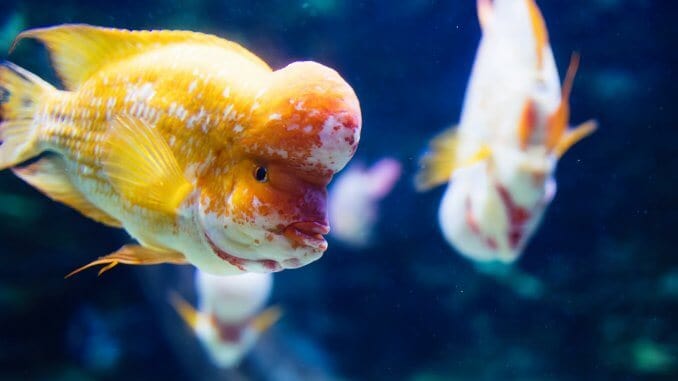
The flowerhorn cichlid is a freshwater species of cichlid. Flowerhorn cichlids have a “flower” marking and a horn-like hump on their heads, giving them the name “flowerhorn.”
Flowerhorn cichlids have been selectively bred for their unique head shapes, and their closest relatives are African cichlids.
There are several types of flowerhorn cichlids, including luohans — the original flowerhorn group — and the four main derived varieties: zhen zhu, kamfa, golden monkey, and the golden base group.
Despite their aggressive tendencies, these fish are popular among aquarists due to their unusual appearance and vivid colors.
TABLE OF CONTENTS
Flowerhorn Cichlid Facts & Overview
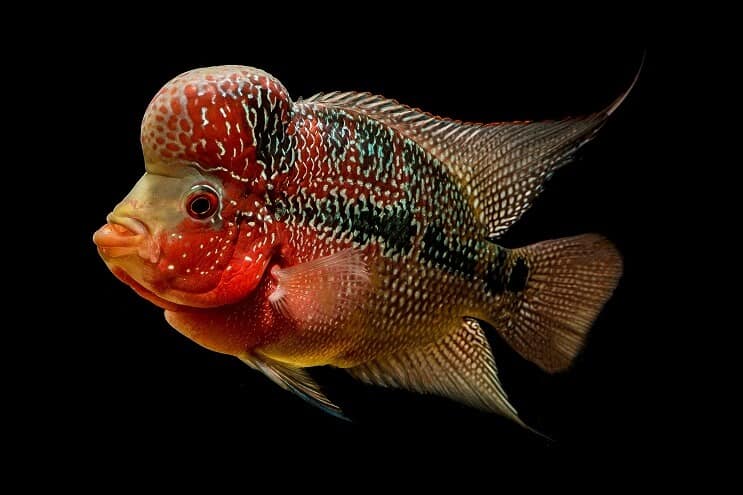
| Scientific name: | Paracheirodon innesi |
| Common names: | Flowerhorn cichlid |
| Distribution: | Malaysia, Singapore, Thailand, Taiwan |
| Size: | 10–16 inches |
| Life expectancy: | 10–12 years |
| Color: | A range of vibrant colors, including green, red, purple, blue, orange, yellow, and pink |
| Diet: | Omnivore |
| Temperament: | Moderate–aggressive |
| Minimum tank size: | 70 gallons |
| Temperature: | 80–89°F (23–31°C) |
| pH: | 6.5–7.8 |
| Hardness: | 9–20 dGH |
| Care level: | Moderate |
| Breeding: | Egg-layer |
Origin
Flowerhorn cichlids are man-made ornamental aquarium fish that didn’t originate from the wild. However, they can be found in the wild because some of these captive-bred fish have been released.
The flowerhorn cichlid was developed in Malaysia, Thailand, and Taiwan, and is found in waters in these regions. In Malaysia and Singapore, flowerhorn cichlids are invasive pest animals. Importing these fish to Australia is illegal.
Adult Size & Lifespan
Fully-grown flowerhorn cichlids reach up to 16 inches long. Females and males are the same size, but females have rounder bellies than males, especially during breeding season.
The average lifespan of a flowerhorn cichlid is between 10 and 12 years.
Availability
Flowerhorn cichlids were originally sold in Asian countries. The fish were imported to America in the 1990s, and are now sold in regions across the world.
However, flowerhorn cichlids aren’t as popular as other cichlid species, and the fish aren’t commonly available in all local or online stores. They are also more expensive than other tropical fish species.
The average cost of a flowerhorn cichlid is $40 to $80, depending on the fish’s markings and colors. Males are more expensive than females because males are more brightly-colored than females and have the statement nuchal hump.
They need to be housed in groups of at least two, bringing the average upfront cost up to $80–$160.
Reputable online stores selling flowerhorn cichlids are:
- Arizona Aquatic Gardens, which sells titanium Thai silk flowerhorn cichlids, strawberry flowerhorn cichlids, golden phoenix flowerhorn cichlids, and red Texas flowerhorn cichlids
- Aquariumfish.net, which sells blue diamond flowerhorn cichlids, red chili flowerhorn cichlids, super red dragon flowerhorn cichlids, and neon dragon flowerhorn cichlids
Appearance & Behavior
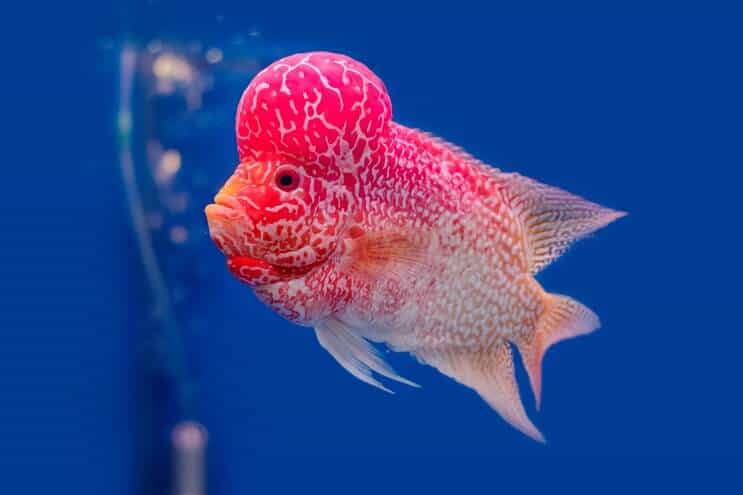
Flowerhorn cichlids are ornamental fish, meaning that they’re developed for their exotic, beautiful, and unusual features. They have semi-aggressive personalities, especially when housed without other fish of their own kind.
Colors, Patterns, Fins, and Sex Differences
The flowerhorn cichlid is a colorful fish with an elongated body and long, pointed dorsal and anal fins, which grow past the fish’s small, short tail.
The defining feature of this fish is its “flowerhorn” — the bulging nuchal (near the nape of the neck) hump, which can grow larger than five inches. Only male flowerhorn cichlids develop nuchal humps. The nuchal hump was traditionally associated with good luck, but anecdotal evidence suggests that the bigger the nuchal hump, the more aggressive the fish.
The flowerhorn cichlid’s dorsal and anal fins are almost braid-like, and the fish’s tail is round and thin. Its pectoral fins are small, elegant, short, and almost transparent.
These fish have been bred in a variety of vibrant colors, including yellow, red, pink, blue, purple, and orange. Black, gray, and white flowerhorn cichlids are also available.
It’s common for flowerhood cichlids to have a merge of several colors on their bodies, often darker at the front of their bodies than the back. White and black marble patterns are found on some individual specimens.
Males are more vibrant than females, particularly when attracting females for breeding. When stressed, flowerhorn cichlids become duller than usual.
Typical Behavior
Flowerhorn cichlids have aggressive personalities and are known to bite, chase, or fight other fish species.
Although they aren’t schooling fish, they prefer one another’s company and swim in pairs. Housing a small group of flowerhorn cichlids in the same tank reduces stress and aggressive behavior among the fish.
Due to their bulky bodies, flowerhorn cichlids swim slowly, moving up and down the water column. They are most active during the day, and they enjoy claiming their territories in caves and rocky sections of the tank.
Flowerhorn Cichlid Care & Tank Requirements
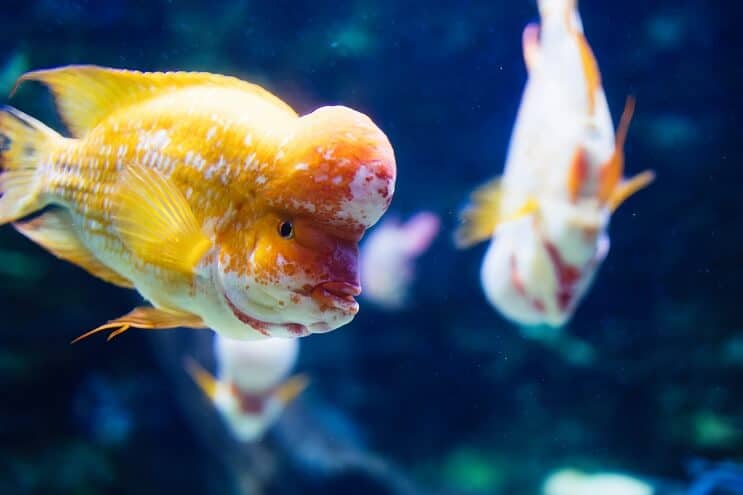
Caring for flowerhorn cichlids is easy as long as you provide the right tank environment and feed the fish a varied omnivorous diet.
Because they have been bred in captivity, the fish’s preferred habitat in the wild is unknown. Replicating the desired habitat of South African cichlids, the flowerhorn cichlid’s closest relatives, is best.
Habitat and Tank Requirements
South African cichlids are used to relatively hard, densely vegetated tropical waters, such as sheltered, slow-moving river basins. Provide similar conditions in the tank to ensure your flowerhorn cichlids are comfortable and at home in their environment.
The ideal tank size for flowerhorn cichlids is at least 70 gallons. A pair of these fish requires a tank size of at least 150 gallons. If you plan to house flowerhorn cichlid fish with other cichlid species, look for large tanks of at least 200 gallons.
Use a filter to ensure the water is clean with a moderate flow, and maintain consistent water parameters to prevent stress and disease.
The best substrate for flowerhorn cichlid tanks is a combination of mono-colored gravel, rocks, and driftwood. These fish enjoy digging in the substrate, so choose a smooth material that won’t damage the fish’s scales.
Decorations like caves and castles allow them to establish their own territories in the tank, and provide a hiding place for nervous cichlids. Make sure the decorations are secured to prevent your fish from knocking or flipping the decorations.
Plants are a good tank addition. Use sturdy, deep-rooted plants like Java fern, anubias, and Java moss to prevent cichlids from ripping the plants from the surface.
Tank Conditions
The ideal tank conditions for a flowerhorn cichlid are:
| Water type: | Slightly hard, slow-flowing freshwater |
| Tank size: | Minimum 70 gallons, or 150 gallons per pair |
| Water temperature: | 80–89°F |
| Substrate: | Pebbles |
| Tank setup: | Plants, rocks, caves, driftwood |
| Acidity: | 6.5–7.8 pH |
| Water hardness: | 9–20 dGH |
| Filter: | Yes, to provide a slow-moving current and keep the tank clean |
| Pump: | Yes, flowerhorn cichlids are messy fish, and pumps provide extra cleaning |
| Bubbler: | Not necessary |
| Lighting: | Yes, lighting mimics the fish’s natural day-to-night cycle and supports plant growth |
| Water heater: | Yes, flowerhorn cichlids are used to warm, tropical waters, which can be maintained with a water heater |
Flowerhorn cichlids produce a lot of waste, so maintaining tank cleanliness with a good filter and frequent water changes is one of the most important aspects of looking after the fish.
Disease
There are several diseases that affect flowerhorn cichlids:
Ich
Ich, or white spot disease, is a common freshwater skin condition, caused by the protozoan Ichthyophthirius multifiliis, which can be transported to the tank by plants, live foods, and other fish. This disease causes salt-like spots on the fish’s body, flashing (rubbing against rough surfaces), lethargy, and loss of appetite.
Quarantine fish affected by ich and add one teaspoon of salt per gallon of water in the tank. Increase the tank’s temperature by two degrees to speed up the lifespan of the protozoan.
Hole in the Head
Hole in the head is a potentially fatal disease caused by a protozoan called Hexamita spp., which is found in poor-quality water. Early signs of hole in the head are small pits and pimples on the fish’s head. Left untreated, these pits grow into white-colored “holes,” sometimes surrounded by mucus.
Fish with hole in the head are lethargic and lose their appetites. Weight loss and white, stringy feces are other signs and symptoms of hole in the head.
Treat hole in the head with veterinarian-recommended antibiotics like metronidazole.
Fungal Infections
Fungal infections can occur on the flowerhorn cichlid’s head, tail, mouth, body, and fins, and are characterized by white, fluffy-looking fungus. Saprolegnia, a bacteria that thrives in poor-quality water, commonly causes fungus in aquarium fish.
Treat fungal infections by adding up to 1 teaspoon of aquarium salts per gallon of water to the tank and using fungus eliminators. Prevent fungus-causing bacteria from returning to the tank by carrying out a complete water change and maintaining clean tank conditions.
Tank Mates
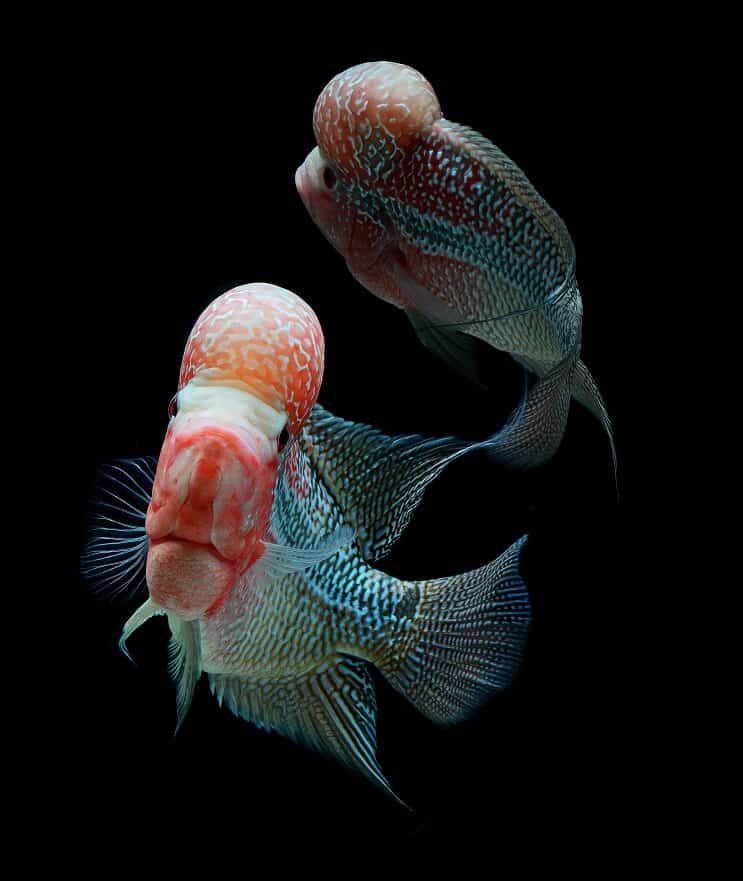
Flowerhorn cichlids are an aggressive species that are incompatible with most other aquarium fish. Don’t house flowerhorn cichlids with small, shy, nervous, or slow-moving fish, or non-fish species like shrimp and crabs, because they prey on these creatures.
Avoid small, overly-active tank mates that could annoy flowerhorn cichlids.
Great tank mates for flowerhorn cichlids are fish of a similar size and temperament, including:
- Other flowerhorn cichlids (Keep the fish in pairs to reduce aggression. Double the tank size to accommodate extra cichlids.)
- Leopard plecos
- Jaguar cichlids
- Giant gouramis
- Suckermouth armored catfish
- Spotted hoplos
Diet and Feeding
Flowerhorn cichlids are big fish with big appetites. The fish are omnivores and eat almost all live and frozen foods.
Protein should make up the bulk of their diet. Provide protein-rich fish flakes designed for large cichlids, and live or frozen foods like bloodworms, shrimp, crickets, and dried grasshoppers.
Plant-based foods should make up about 30% of the fish’s diet. Algae wafers, prepackaged vegetable fish foods, and blanched spinach are good plant-based foods to add to the tank.
Feed flowerhorn cichlids up to three times per day, providing enough food for the fish to eat within five minutes. Provide a generous pinch of food and reduce portion sizes if food is left over after a feeding session.
As long as you provide a high-protein, varied diet for your fish, flowerhorn cichlids don’t require additional supplements.
Breeding
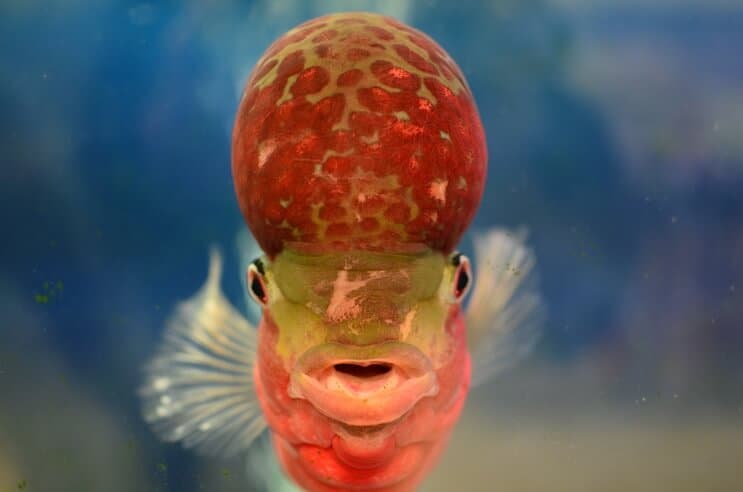
Flowerhorn cichlids are easy to breed when the fish feel comfortable in their tank. At eight to 12 months old, these fish are sexually mature and ready to breed. Some breeders wait until the fish reach at least 18 months old to increase the likelihood of breeding success.
To breed flowerhorn cichlids, follow these steps:
- Select the parent fish that you wish to breed, depending on the traits you’d like the parents to pass onto the baby fish. Place the fish in a large 150-gallon aquarium with the same water conditions as the home tank, flat rocks on the substrate, and a glass divider separating the pair.
- Feed them a high-protein diet of live bloodworms to prepare the fish for breeding. Treat the water with an antifungal solution before removing the glass separation screen.
- If the fish are interested in breeding, the female will clean a flat rock where she plans to lay her eggs, and the male will chase the female around the tank. Once the male successfully inseminates the female, the female’s belly will grow bigger to indicate the production of eggs.
- The female will lay between 700 and 1,000 eggs on a flat rock, and the male will fertilize the eggs. The parents will guard the eggs for two to three days, until they hatch.
- Feed the fry baby brine shrimp. Remove the parents two to three days after the fry have hatched to prevent the parents from eating the babies.
- Once the fry grow to two inches long, introduce flakes, pellets, daphnia, and tubifex worms to their diets. Move the fry to their own tanks once they reach adult size – at six to eight months old.
Should You Get a Flowerhorn Cichlid for Your Aquarium?
Flowerhorn cichlids are colorful, beautiful fish that are fascinating to watch as they majestically swim in an aquarium.
You should consider getting a flowerhorn cichlid if you have the budget to buy a large tank and plenty of food for this large fish species. Don’t get this fish if your tank contains small, shy, or slow-moving fish that flowerhorn cichlids are known to bully.
Despite their aggressive tendencies, they are highly sought-after fish that look truly unique amongst other aquarium fish.

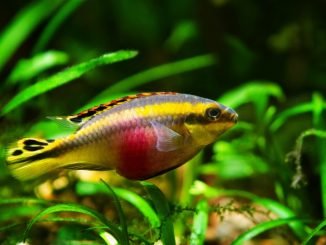
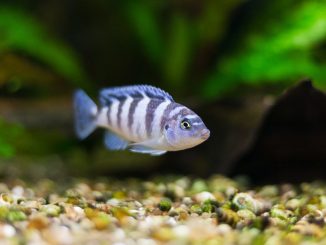
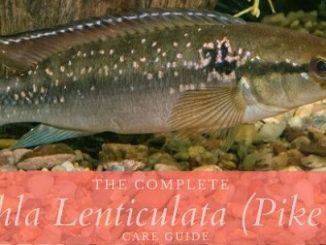
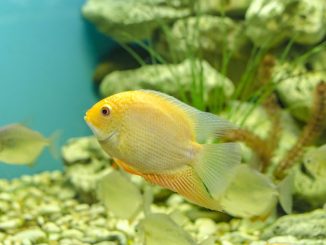
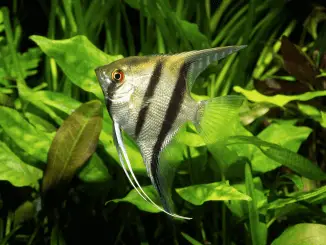
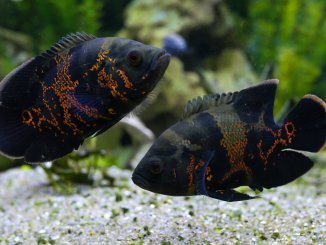
Be the first to comment